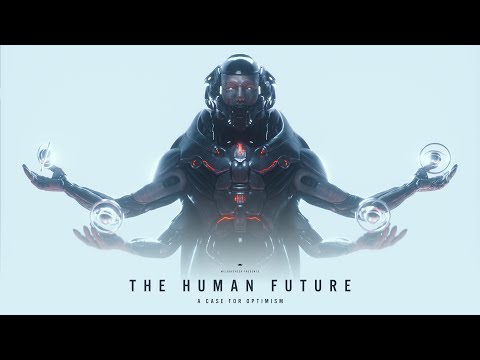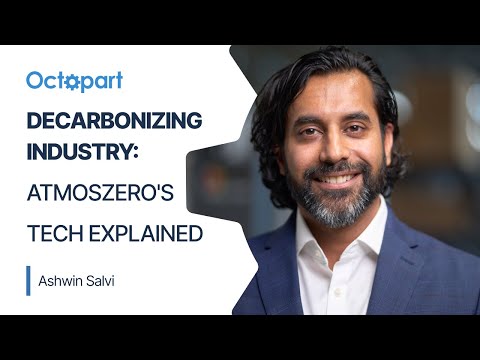THE HUMAN FUTURE: A Case for Optimism

Humanity is at a tipping point: We stand at a crossroads of accelerating change unlike anything ever seen in the history of life. It feels as if the future could tip either way. Between utopia and apocalypse. The risks we face are daunting.
But beneath the rampant pessimism for our future is evidence that humanity can not only survive the coming centuries, but thrive deep into the future. No one knows what comes next. But there are three broad paths our future could take. The first is Collapse: a major catastrophe threatens the downfall of civilization and possibly even extinction of the human race. Second is Plateau: where mankind averts collapse, but hits an upper limit of progress. And third is Transcendence: where humanity reaches its full potential, multiplies into the trillions, or transforms along the way into something entirely unimaginable.
Envisioning these futures will clarify the risks we face, and the promise we have, as we step into an unpredictable new era, for planet Earth, and for ourselves. Mankind is no stranger to catastrophe. Our ancestors have survived asteroid impacts, ice ages, supervolcano eruptions, and deadly plagues, each time bouncing back to new heights. But our biggest threats no longer come from the natural world... they come from ourselves. Since the dawn of nuclear weapons, the threats of self-destruction have come to dwarf all others.
By some estimates, the risk of causing our own extinction is over 300 times higher than extinction by natural causes. The Future of Life institute identifies 4 main risks to our survival Nuclear War, Climate Change, Biotechnology, and A.I. To comprehend the gravity of these risks, we have to envision their worst possible outcomes. The soot from a large-scale nuclear war could cool global temperatures by nearly 10 degrees and wipe out up to 63% of the population. We have made strides in reducing nuclear stockpiles, but there are nearly 10 000 warheads still in existence.
Currently, we are on track to heat the earth by around 2.7 degrees by 2100, which could displace over a billion people. But in the worst case, we could trigger C02 tipping points and could cause up to 12 degrees of warming in the coming centuries. Biotechnology has the potential to solve major crises like food scarcity and disease, but could give small groups of people the power to cause global disaster. In theory, the release of a designer pathogen could have an even higher death toll than a global nuclear war.
But the hardest risk to gauge stems from A.I. It’s the first threat we’ve faced that we may not be able to out-smart. It could become a powerful ally or it could ultimately outcompete us for the world’s resources and push humanity into obscurity. Navigating this new risk landscape will be the biggest challenge we have yet faced. And new, unknown threats are bound to materialize the more we progress. But despite the potential for large-scale human tragedy, few of these risks on their own are likely to lead to our total extinction.
In fact, we may be one of the least endangered species on Earth. Our sheer numbers and broad distribution have given us a geographical buffer against extinction. We inhabit every corner of the Earth, from desert to tundra and tiny isolated islands, which could act as natural quarantines. in case of global disaster. Even if 99.9% of humans
were eliminated in some catastrophe 8 million of us would remain, more than existed for most of our history. And although we are slow to reproduce, we no longer rely on the glacial pace of natural selection to adapt. Technology gives us the power to adapt thousands of times faster than any other species in the history of life. Lastly, our generalist diets allow for a wide flexibility in food sources, a trait that was critical to survivors of past mass extinctions. Ultimately, the threat of collapse hinges on one question: how resilient is civilization? How big of a hit can we take, and keep going? The black death of 1347 killed up to half the population of Europe and 1/10th of people globally. But even this did not derail human progress… and it was followed by the scientific revolution just two hundred years later.
The same proportional hit today would wreak havoc on our inner connected global economy. But as long as our infrastructure and knowledge remained, we could still rebound and maintain an upward momentum. If we suffered a collapse steep enough to extinguish global industry, it would make for a much longer, more precarious recovery.
And If we somehow lost the capability for agriculture, and were pushed back to hunter-gatherer lifestyles, the Earth could only support 10 million of us, our population as it was a hundred centuries ago. At minimum, there would need to be between a 100 and 5000 survivors to successfully repopulate the Earth Below that level, the bottleneck would be too tight, and we might never recover. To comprehend what’s at stake, we have to confront what extinction would actually mean. Our greatest threat comes not from a single disastrous event, but from the compounding effects of disasters that overlap and mix together in unpredictable ways. In 2009 two researchers conducted a thought experiment to see what it would take to drive humanity to complete extinction. Phase I sees a rapid crash in human population from global warfare and collapse of global industry and agriculture.
Phase II sees the exhaustion of remaining natural resources over the following two centuries. And Phase III envisions a downward spiral of ecosystem collapse, punctuated by a supervolcano eruption, leaving the last remaining bands of humanity unable to cling on any longer. Such an outcome would not only be tragic for the loss of life, but for the loss of future potential life. Billions or even trillions of our potential descendants would never materialize. Distant planets would go unexplored.
It would mark the end of music, poetry, and art in our corner of the galaxy, and possibly in the entire universe. The Svalbard Global Seed Bank in Norway now holds over a million seed specimens for over 4 000 species of plant, which could someday be a critical resource for rebuilding civilization. But there’s an even better place to build a vault like this.
Some have proposed lunar arks that would store genetic samples in lava tubes beneath the moon’s surface. Here, they would be protected from global disaster, erosion, micrometeorites, and solar radiation. But the best way to secure our long-term survival is to take the leap that no other life form has ever taken: to become a multiplanetary species. Once a self-sustaining civilization is establishedon another planet, the chances of our extinction will plummet. We will carry our flaws with us, and we will face new and unknown risks the further we stray from Earth, but it will be worth it.
a sustainable, interplanetary civilization will be the foundation for a long and prosperous future. But is this higher future actually in reach, or are we at the peak of our powers? How far can we go? In theory, it’s possible that civilization will hold the status quo for the indefinite future, avoiding both collapse and transformation. There could be unforeseen barriers that keep us in a kind of uneasy stasis. But in reality, Plateau will be a temporary state at best.
In the short-term, exponential changes in technology and Earth’s climate will force civilization into new directions. And the further we push into the future, the greater the disruptions we will face. In the next few hundred thousand years, we are due to face supervolcano eruptions and a new ice age, even if we burn every ounce of fossil fuels and bake the Earth.
Without active climate management, the glaciers will have their revenge, as mile thick sheets of ice steamroll huge swaths of North America and Europe. It’s believed that around every 27 million years, Earth experiences a cyclical mass extinction, caused by the sun passing through the asteroid-dense middle region of our galaxy. And around a billion years from now, the brightening of the sun will make Earth too hot for photosynthesis, and the oceans will slowly boil away, snuffing out all life on our planet.
Modern civilization will not survive these events without a deep transformation. One option will be to let nature run its course on Earth, and move to off world habitats. Bishop Rings are circular megastructures that could house over a billion people. They could provide over 3 million square kilometers of land, as much as India or Argentina. They could be built with lightweight carbon nanotubes, and their rotation would generate enough gravity to hold their own atmosphere. But if we decide to stay Earth-bound, we are not at the mercy of our planet.
We have the power to write its future. Despite all the dangers we face, utopian futures are well within reach and sooner than we might think. To our ancestors, our current powers would appear god-like. But everything we have achieved so far may pale in comparison to what comes next. Since the industrial revolution, technological progress has been radically improving the human condition in every critical way.
Worldwide, quality of life is at an all time high. We don’t perceive these positive trends as clearly due to our negativity bias, which evolved to make us extra attentive to negative information. But the forward momentum is undeniable. Our course correction to a sustainable civilization now appears unstoppable. The costs of solar and wind energy are falling faster than expert predictions, making them often cheaper than fossil fuels. At the same time, converging advancements in A.I. and biotech
are pointing toward a radical enhancement of human well being. Already, projects like AlphaFold are discovering structures of pathogens and treatments for cancer far faster than humans could. There are over 10,000 diseases that are caused by single gene mutations and gene editing tools like CRISPR have the potential to cure all of them.
These upward trends are multiplying the human potential many times over. We are now the healthiest, wealthiest, freest, most educated, most advanced population of humans to ever exist. If these trends hold, we could gain the power to regenerate limbs, eliminate all disease, and possibly extend our life spans indefinitely. putting us on the brink of the most radical transformation in our history. Achieving these breakthroughs will require technological leaps that the human mind alone cannot make. But already, NASA has begun to use AI to design mission hardware, outperforming human designs by a factor of three.
It’s also being pioneered in the development of cleaner biofuels and drought-resistant crops, which could be critical in the fight against climate change. And this is just the start. We are witnessing the beginning of an intelligence explosion.
which could lead to an Artificial Super Intelligence that far exceeds human capabilities. able to solve complex problems have have defied humanity. Aligning it to human values will be a huge and novel challenge. But it will be a vital step. Not just for the enormous prosperity it could bring, but to counter the threat of malicious AIs A safely aligned super intelligence should be a prime objective for human progress. If we can safely harness the power of AI for human betterment, then we can paint a utopian future our ancestors could hardly fathom.
A future free of disease and hunger, where biotechnology has stabilized the climate and biodiversity. Where abundant clean energy is developed in concert with AI; Where breakthroughs in rocketry and materials sciences have propelled humans to distant planets and moons; And where new tools for artistic and musical expression open new frontiers of beauty, experience, and understanding. And all of this could be just the prologue to an even grander future. If our energy use continues its exponential growth, we could eventually control more energy than the Earth itself receives, becoming a Type 1 Civilization. A recent study shows this could occur as soon as the year 2371. And by maintaining 3% yearly growth, we would reach Type 2 in just a few thousand years.
Able to control all the energy from the sun. If our species survives until the death of the sun in 5 billion years, it could lead to the existence of some 600 quadrillion people. And by colonizing space, vastly more still could come into existence, something like a hundred a hundred thousand a hundred thousand trillion a hundred thousand trillion trillion a hundred thousand trillion trillion people in the milky way. But the farther we spread into space and time, the more different we will become. It’s possible that we will splinter into multiple species, each with a different tolerance for change.
Some may choose to merge with our machines into a new hybrid species, rejecting natural selection in favor of technological evolution. While others may choose to remain fully biological. This splintering would mark the first time since the Neanderthals more than one human-like species walked the Earth.
And if we ever come to digitize our consciousness, human identity could branch into an infinite number of varieties. As we grow into new, more powerful forms, we will eventually have to confront a profound question: what is our ultimate purpose in the universe? We could aim for the lofty goal of colonizing the entire galaxy, of becoming a type 3 civilization and reordering the milky way to our own designs. We could aim to outlive the stars themselves, in some one hundred trillion years. But these far-off dreams are not for us to realize.
If they are ever achieved, it will be by some distant descendant of ours, evolved far beyond their human roots. Instead, perhaps humanity’s ultimate goal should be a more personal one: to save the Earth, he little rocky planet where it all began. By pulling Earth away from the expanding sun, we could prolong the game of life by billions of years.
This could be done by building a giant conductive counterweight on the far side of the moon. The process would take millions of years. But it would be a truly worthy goal, to offset the destruction we have caused and keep life flourishing for eons more.
A final act of redemption for humanity. Only the worst-case scenarios can stop us. If we can avoid them, we have the potential to seed a vast new branch of life that could outgrow Earth itself and spread across the universe. If there is one lesson our history can teach us, it’s to never underestimate the human race. Subtitles Subtitles by Subtitles by O.
Subtitles by O. Wieting Subtitles by O. Wieting & Subtitles by O. Wieting & Melodysheep
2023-08-22 06:01


